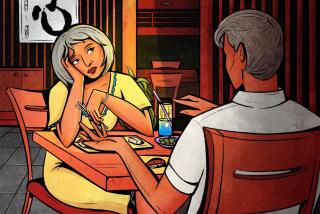The Right Equation
- Share via
One of my best friends, Richard Rouilard, died a year ago this week. In the 10 years I knew him, I don’t recall Richard ever cooking anything. In fact, I believe him to have been constitutionally unable to do anything more than smear jam on toast. He would howl at even being mentioned in a food section.
In Rouilard-land, one dined out or ordered in. Cooking was something other people did--most frequently his longtime partner, Bob Cohen--and Richard seemed to regard it as an amusing, if sometimes handy, hobby.
But no one could throw a dinner party like Rouilard.
Until our paths crossed--he was the society writer at the old Herald-Examiner when I was the food editor--my dinners were pretty much the usual foodie-type events. Nice, but conversation usually centered on either the food and the wine or the wine and the food.
I still remember my first Rouilardian dinner party. The courtyard of his Whitley Heights home was lit like an opera stage, with dramatic interplay of light and shadow and candles flickering on every table. There were flower arrangements that looked as if an entire botanical garden had been stripped bare. There were 30 or 40 people that night, and my wife and I found ourselves at a table with Timothy Leary and his wife and David Hockney and Ian Falconer, and I haven’t the slightest idea what we ate.
That was quintessential Rouilard. When he threw a dinner party, the accent was on the second word, not on the first. Although the food was almost always good, he never gave it much thought. “Oh, just throw something together and we’ll put it on the nice plates,” he’d say. Of course, the reality was much different, but he knew the right caterers and had friends who could cook--why waste time on the menu?
Rouilard did not throw dinner parties so much as produce them, and opening night at the Met never got as much attention as one of his soirees. He would pore over the guest list, getting just the right cast of just the right people. Artists, writers, decorators, editors, actors, designers, chefs, musicians, historians, general contractors and even food writers were equally welcome; the only requirement was that he found you interesting.
Once the cast was settled, he would agonize over the flowers and the music. Then he’d make sure he made all the right introductions and fade into the background to watch the production unfold, circulating here and there to give conversation a prod if he felt it was lagging.
Food was basically stage business to keep the actors occupied during lulls in the script.
For the cook in me, that took some getting used to. Actually, I’m not sure I ever really did. He’d still say I think too much about food. (“You cooked it, I ate it, do we have to talk about it too?” is another quote that comes to mind.) But I did learn from him a lot about what I’m grudgingly willing to admit is the other 50% of the dinner party equation.
We can share only the talents we have; we give each other what we are able. Rouilard may not have known which end of a whisk to hold, but he was a master at mixing people. His contribution was his uncanny ability to pull together disparate individuals into a more interesting whole. I’ve never met anyone who was his equal in that.
I’m still a hopeless foodie, though, and the dinner I remember most was Easter last year. Richard was seriously failing by then. In fact, the meal had to be moved from our house to his at the last minute because he wasn’t up to the car ride. But that afternoon he ate two helpings of my roast leg of lamb, and I couldn’t have been more proud.
In his last weeks, his house was always full of people. Dropping by at any time of day or night, you could count on finding a couple of friends, at least, sitting with him back in the bedroom, watching American Movie Classics and cattily discussing the collected works of Joan Crawford and Bette Davis. (Rouilard could recite almost the entire screenplay for “The Women” from memory, with footnotes on set design and wardrobe.)
Some friends started gathering at his house one night a week for dinner. I cooked at one of them--a shiitake mushroom and asparagus risotto inspired, quite frankly, by what looked good at the grocery store I stopped at on my way from work. To give the meal a little more weight, I broiled lamb rib chops and perched them atop the risotto--a very un-Italian thing to do, I know, but there were hungry people to feed.
While I cooked in the kitchen, I could hear the hum of conversation in the dining room, occasionally a little too bright as people tried to talk about anything but what we all knew would come too soon.
When dinner was ready, Rouilard hobbled out, propped himself at the table, steered conversations, made wisecracks and pushed the risotto around on his plate. The most important thing was that he was at the center of a party. Food never interested him that much, anyway, though dinner certainly did.
RISOTTO OF ASPARAGUS AND SHIITAKE MUSHROOMS
If you want to serve lamb chops with the risotto, be sure to add any lamb trimmings, browned well, to the stock. A few trimmings and a lot of water will give you the right balance. A good risotto tastes of itself--the rice and the principal ingredients--not of a strong stock.
1 1/2 pounds asparagus
3 fresh shiitake mushrooms (about 1/4 pound)
3 cups chicken broth
Butter
1 large clove garlic, or 2 small
3 cups Arborio rice
1 teaspoon minced rosemary
1/2 cup grated Parmigiano-Reggiano
Salt
Hold spear of asparagus by both ends and bend. Spear will snap at tender spot. Reserve tops and place tough ends in 6-quart saucepan or stockpot with tough mushroom stems and chicken broth. Add water to fill to top and bring to boil.
Meanwhile, melt 2 tablespoons butter in large skillet over medium heat. Add garlic and cook until lightly colored, about 5 minutes. While garlic is cooking, cut away tips of asparagus and reserve. Slice remaining asparagus parts in 1/4-inch sections. Cut mushrooms in quarters. Add thinly sliced asparagus (not tips) and mushrooms to skillet and cook, stirring, until barely softened, 2 to 3 minutes.
Add rice and cook, stirring, until rice begins to “sing” when stirred across bottom of pan, about 1 minute. Ladle 1 cup boiling broth through strainer into rice and stir until completely absorbed by rice. Bottom of pan should be clean when stirred. Continue adding broth, 1 cup at a time, cooking and stirring, until liquid is absorbed. After third cup of stock, add reserved asparagus tips and continue cooking, adding stock 1 cup at a time, until rice is tender. You will need 6 1/2 to 7 1/2 cups of broth. Finish risotto with 1/2 cup stock, just enough to give barely soupy texture. Remove from heat and vigorously beat in rosemary, 2 tablespoons butter and grated cheese. Remove garlic. Season to taste with salt.
Risotto must be served immediately.
6 to 8 servings. Each of 8 servings:
372 calories; 468 mg sodium; 21 mg cholesterol; 9 grams fat; 62 grams carbohydrates; 12 grams protein; 1.23 grams fiber.
More to Read
Eat your way across L.A.
Get our weekly Tasting Notes newsletter for reviews, news and more.
You may occasionally receive promotional content from the Los Angeles Times.











